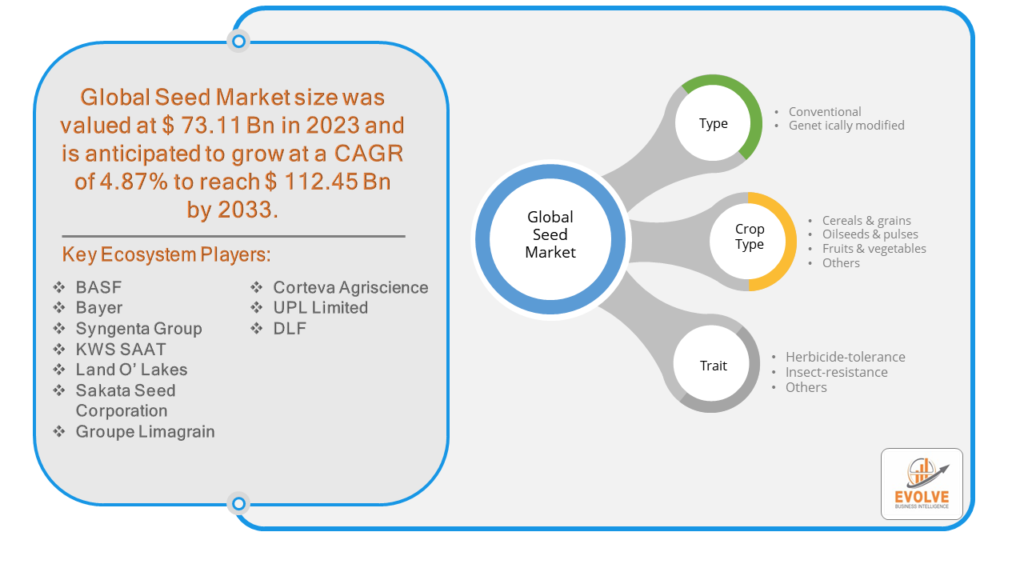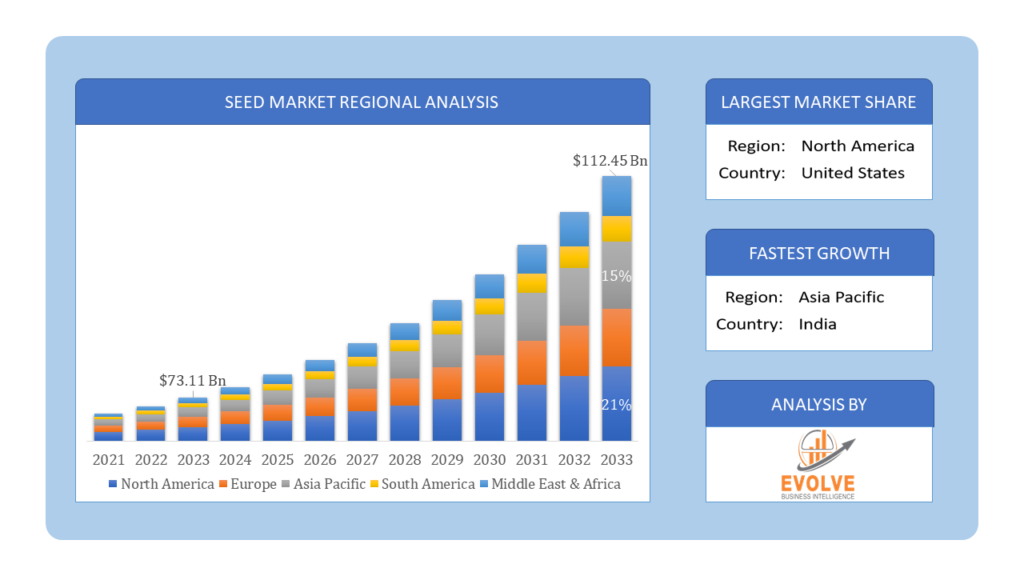Seeds market Overview
The Seeds market Size is expected to reach USD 112.45 Billion by 2033. The Seeds market industry size accounted for USD 73.11 Billion in 2023 and is expected to expand at a compound annual growth rate (CAGR) of 4.87% from 2023 to 2033. The seeds market refers to the global marketplace for seeds used in agriculture, horticulture, and landscaping. This market encompasses a wide variety of seeds, including those for staple crops like corn, wheat, and rice, as well as seeds for vegetables, fruits, flowers, and ornamental plants.
The seeds market is diverse and dynamic, driven by factors such as changes in agricultural practices, advancements in biotechnology, shifts in consumer preferences, and environmental concerns. Companies involved in the seeds market range from multinational corporations specializing in genetically modified seeds to smaller regional seed producers focusing on traditional, heirloom varieties. The seeds market plays a crucial role in global food security and biodiversity conservation, as it influences the availability of crop varieties, their genetic diversity, and the sustainability of agricultural practices.
Global Seeds market Synopsis
The COVID-19 pandemic had various impacts on the seeds market. Restrictions on movement and trade disruptions caused by lockdown measures and border closures have disrupted the supply chains for seeds. This has affected the transportation of seeds from production facilities to distribution centers and ultimately to farmers. The pandemic has led to shifts in consumer behavior and preferences, affecting the demand for certain types of seeds. For example, there has been increased demand for vegetable seeds as more people have turned to gardening to grow their own food during lockdowns. Farmers have faced challenges in accessing seeds due to disruptions in supply chains and logistical issues. This has affected their ability to plant crops on time, potentially leading to reduced yields and income. The pandemic has also affected research and development activities in the seeds sector. Some companies may have faced delays in breeding programs or testing new seed varieties due to restrictions on field trials and laboratory work.
Seeds Market Dynamics
The major factors that have impacted the growth of Seeds market are as follows:
Drivers:
Ø Technological Advancements
The world’s population continues to grow, driving increased demand for food. This necessitates higher agricultural productivity, which in turn drives demand for high-yield and disease-resistant seeds. Advances in biotechnology, including genetic engineering and gene editing techniques, enable the development of seeds with desired traits such as higher yields, pest resistance, and tolerance to environmental stresses. Increasing consumer awareness about food safety, sustainability, and environmental concerns influences demand for seeds produced through sustainable and organic farming practices. International trade agreements, tariffs, and trade restrictions impact the flow of seeds across borders, affecting market access for seed producers and farmers.
Restraint:
- Public Perception and Opposition
Concerns among consumers and advocacy groups about the safety, environmental impact, and ethical implications of GMOs and other biotechnologies can lead to public opposition and regulatory restrictions, limiting market access for certain types of seeds. The seeds market is dominated by a few large multinational corporations, leading to concerns about market concentration, monopolistic practices, and limited competition, which can affect seed prices, innovation, and farmer choice. Continuous evolution and adaptation of pests, diseases, and weed species can lead to the development of resistance against existing seed technologies, necessitating ongoing research and innovation to develop new solutions.
Opportunity:
⮚ Population Growth and Food Security
With the world’s population expected to continue growing, there is a growing need to increase agricultural productivity to ensure food security. This creates opportunities for seed companies to develop high-yield, disease-resistant, and climate-resilient seed varieties to meet the increasing demand for food. Increasing consumer awareness about health, nutrition, and culinary diversity is driving demand for specialty crops such as organic vegetables, heirloom fruits, and exotic herbs. This creates opportunities for seed companies to develop and market seeds for niche and specialty crops. The adoption of digital agriculture technologies, including precision farming, data analytics, and remote sensing, creates opportunities to optimize seed selection, planting practices, and crop management for improved yields and resource efficiency.
Seeds market Segment Overview
By Type
 Based on Type, the market is segmented based on Conventional and Genetically modified. The G.M. seeds segment dominated the market. These seeds help farmers to lower their running costs significantly.
Based on Type, the market is segmented based on Conventional and Genetically modified. The G.M. seeds segment dominated the market. These seeds help farmers to lower their running costs significantly.
By Crop Type
Based on Crop Type, the market segment has been divided into Cereals & grains, Oilseeds & pulses, Fruits & vegetables and Others. The cereals & grains category segment dominated the market owing to the rising consumer demand for healthier food options and increased breakfast cereal consumption.
By Trait
Based on Trait, the market segment has been divided into Herbicide-tolerance, Insect-resistance and Others. The herbicide tolerant category segment dominated the market as these give the species resilience and the inborn capacity to tolerate and reproduce. This trait enhances weed management efficiency, reduces labor costs, and promotes sustainable practices by minimizing herbicide use.
Global Seeds market Regional Analysis
Based on region, the global Seeds market has been divided into North America, Europe, Asia-Pacific, the Middle East & Africa, and Latin America. North America is projected to dominate the use of the Seeds market followed by the Asia-Pacific and Europe regions.
 Seeds North America Market
Seeds North America Market
North America holds a dominant position in the Seeds market. North America, particularly the United States and Canada, is a major player in the global seeds market. The region is known for its advanced agricultural technology and large-scale commercial farming operations. Key crops include corn, soybeans, wheat, and cotton. Major seed companies such as Monsanto (now part of Bayer), DuPont Pioneer, and Syngenta have a strong presence in this region.
Seeds Asia-Pacific Market
The Asia-Pacific region has indeed emerged as the fastest-growing market for the Seeds market industry. The Asia-Pacific region is characterized by a wide range of climates and agricultural systems, from smallholder farms to large commercial operations. China and India are major producers and consumers of seeds, with a significant focus on rice, wheat, maize, and vegetables. The region also has a growing market for hybrid seeds and biotechnology products.
Competitive Landscape
The global Seeds market is highly competitive, with numerous players offering a wide range of software solutions. The competitive landscape is characterized by the presence of established companies, as well as emerging startups and niche players. To increase their market position and attract a wide consumer base, the businesses are employing various strategies, such as product launches, and strategic alliances.
Prominent Players:
- BASF
- Bayer
- Syngenta Group
- KWS SAAT
- Land O’ Lakes
- Sakata Seed Corporation
- Groupe Limagrain
- Corteva Agriscience
- UPL Limited
- DLF
Key Development
In July 2022, Corteva Agriscience, BASF, and MS Technologies signed Agreement to develop next-generation Enlist E3 soybeans with the nematode-resistant soybean (NRS) trait for farmers in the United States and Canada.
In June 2022, A new range of tropicalized lettuce is introduced, which is named Arunas RZ. This is expected to boost the market share of the company.
In May 2022, Syngenta Canada has introduced new Pelta seed pelleting technology for canola, which helps in optimizing seed size and uniformity, enabling improved singulation planter performance.
Scope of the Report
Global Seeds Market, by Type
- Conventional
- Genetically modified
Global Seeds market, by Crop Type
- Cereals & grains
- Oilseeds & pulses
- Fruits & vegetables
- Others
Global Seeds market, by Trait
- Herbicide-tolerance
- Insect-resistance
- Others
Global Seeds market, by Region
- North America
- US
- Canada
- Mexico
- Europe
- UK
- Germany
- France
- Italy
- Spain
- Benelux
- Nordic
- Rest of Europe
- Asia Pacific
- China
- Japan
- South Korea
- Indonesia
- Austalia
- Malaysia
- India
- Rest of Asia Pacific
- South America
- Brazil
- Argentina
- Rest of SouthAmerica
- Middle East &Africa
- Saudi Arabia
- UAE
- Egypt
- SouthAfrica
- Rest of Middle East & Africa
| Parameters | Indicators |
|---|---|
| Market Size | 2033: $112.45 Billion |
| CAGR | 4.87% CAGR (2023-2033) |
| Base year | 2022 |
| Forecast Period | 2023-2033 |
| Historical Data | 2021 |
| Report Coverage | Revenue Forecast, Competitive Landscape, Growth Factors, and Trends |
| Key Segmentations | Type, Crop Type, Trait |
| Geographies Covered | North America, Europe, Asia-Pacific, Latin America, Middle East, Africa |
| Key Vendors | BASF, Bayer, Syngenta Group, KWS SAAT, Land O’ Lakes, Sakata Seed Corporation, Groupe Limagrain, Corteva Agriscience, UPL Limited and DLF |
| Key Market Opportunities | • Population Growth and Food Security • Digital Agriculture and Precision Farming |
| Key Market Drivers | • Technological Advancements • Consumer Awareness |
REPORT CONTENT BRIEF:
- High-level analysis of the current and future Seeds market trends and opportunities
- Detailed analysis of current market drivers, restraining factors, and opportunities in the future
- Seeds market historical market size for the year 2021, and forecast from 2023 to 2033
- Seeds market share analysis at each product level
- Competitor analysis with detailed insight into its product segment, Government & Defense strength, and strategies adopted.
- Identifies key strategies adopted including product launches and developments, mergers and acquisitions, joint ventures, collaborations, and partnerships as well as funding taken and investment done, among others.
- To identify and understand the various factors involved in the global Seeds market affected by the pandemic
- To provide a detailed insight into the major companies operating in the market. The profiling will include the Government & Defense health of the company’s past 2-3 years with segmental and regional revenue breakup, product offering, recent developments, SWOT analysis, and key strategies.






